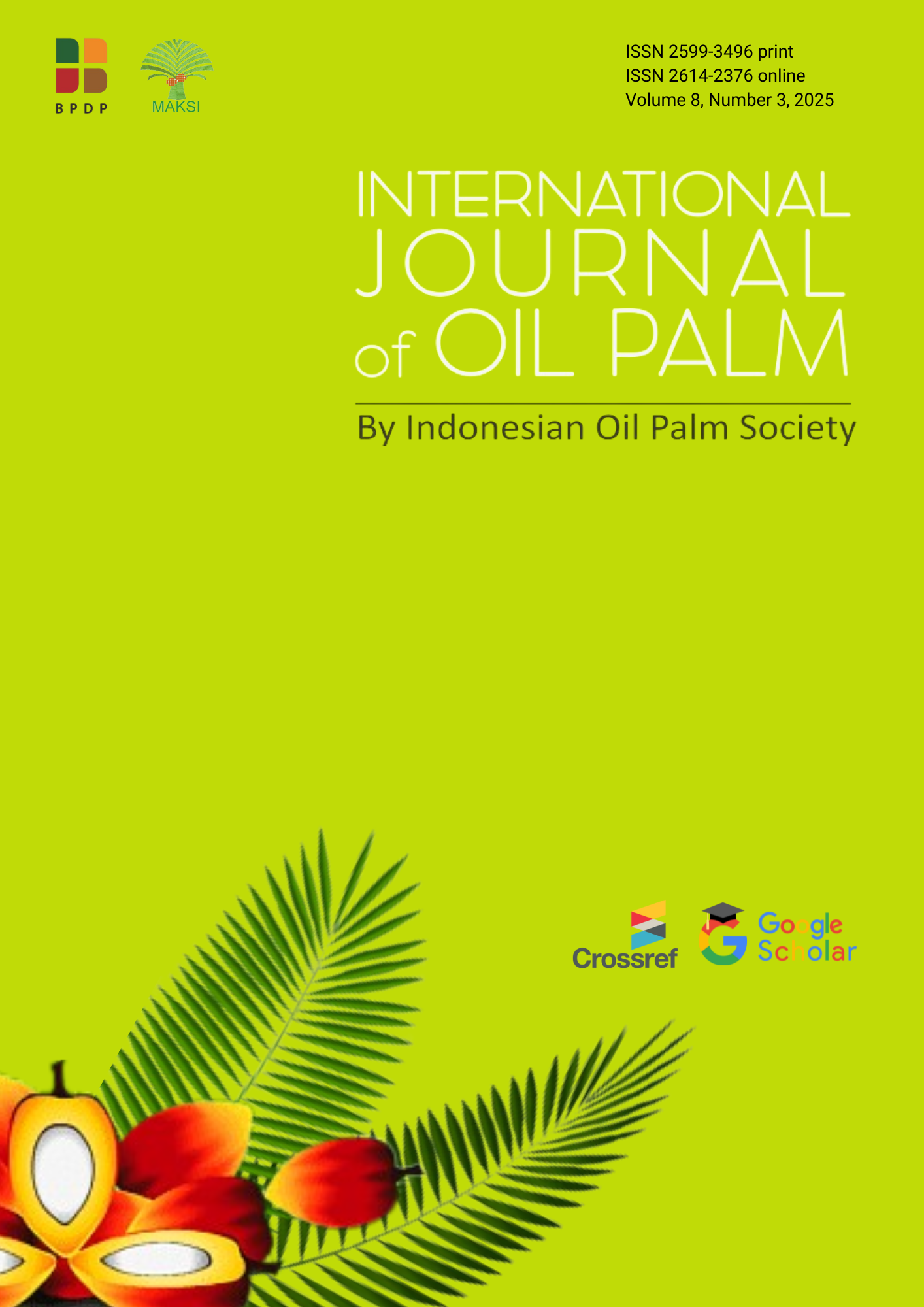Design and Feasibility Analysis of an integrated Zero-Waste Palm Oil biorefinery for Sustainable Aviation Fuel Production and Greenhouse Gas Mitigation
DOI:
https://doi.org/10.35876/ijop.v8i3.165Keywords:
Palm Oil WasteCircular Bioeconomy, Life Cycle Assessment (LCA), Sustainable Aviation Fuel (SAF), Zero-Waste biorefineryAbstract
This study aims to design and assess the technical, environmental, and economic feasibility of an integrated Zero-Waste Palm Oil biorefinery for the production of Sustainable Aviation Fuel (SAF) and other value-added co-products. A quantitative-descriptive approach was employed, integrating process simulation using Aspen Plus V14, Life Cycle Assessment (LCA), and financial modeling to evaluate the system’s performance and sustainability. Primary data were obtained from operational palm oil mills. In contrast, secondary data were sourced from the International Energy Agency (IEA), the International Renewable Energy Agency (IRENA), Statistics Indonesia (BPS), and the Ministry of Energy and Mineral Resources (ESDM) during 2023–2024. The results demonstrate that the integrated biorefinery configuration, which combines thermochemical conversion pathways (pyrolysis, gasification, and Fischer–Tropsch synthesis) with biochemical processes (anaerobic digestion), achieves a mass conversion efficiency of 58.4 percent, net energy efficiency of 72 percent, and an Energy Return on Investment (EROI) of 4.97, exceeding the global bioenergy feasibility threshold of three. The LCA results indicate total Life-cycle emissions of 17.3 g CO?-eq per MJ, representing an 80.6 percent reduction relative to fossil-based Jet A-1 fuel, thereby meeting both CORSIA and RED II sustainability standards. The system also achieves a 95 percent reduction in solid residues, effectively realizing a near-zero-waste operation. Financial modeling reveals a net present value (NPV) of USD 68.2 million, an internal rate of return (IRR) of 17.6 percent, and a payback period of 6.2 years, confirming the project’s economic viability. Overall, this model establishes a scalable pathway for decarbonizing the palm oil industry through circular bioeconomy principles and positions Indonesia as a potential global hub for SAF production aligned with international carbon reduction targets.
Downloads
References
Aboul-Kassim TA & Simoneit BR. 1993. Detergents: A review of the nature, chemistry, and behaviour of the aquatic environment. Part I: Chemical composition and analytical techniques. Critical Reviews in Environmental Science and Technology. 23(4): 325–376.
Anwar D, Simanjuntak EE, Sitepu I, Kinda MM, Nainggolan EA, & Wibowo YG. 2024. Thermophilic digestion of palm oil mill effluent: Enhancing biogas production and mitigating green-
house gas emissions. Jurnal Presipitasi: Media Komunikasi dan Pengembangan Teknik Lingkungan, 21(3): 734746. https://doi.org/10.14710/presipitasi.v21i3.734-746
[BPS] Badan Pusat Statistik. 2023. Statistik kelapa sawit Indonesia 2022/2023. BPS.
[BRIN] Badan Riset Nasional (BRIN). 2021. Pemanfaatan tandan kosong kelapa sawit (TKKS) dalam konteks energi dan pertanian. BRIN Press.
Cheah WY, Siti-Dina RP, Leng STK, Er AC, & Show PL. 2023. Circular bioeconomy in palm oil industry: Current practices and future perspectives. Environmental Technology & Innovation. 30: 103050.
Global SAF Alliance. 2024. Investment report on SAF production facilities: The urgency for deployment. Alliance Publications.
Hall CAS, Lambert JG, & Balogh SB. 2014. EROI of different fuels and the mplications for society. Energy Policy. 64: 141–152.
Hidayatno A, Setiawan AD, Subroto A, Saheruddin H, Wardono S, Romijn H, Zahari TN, Rahman I, Jafino BA, Moeis AO, Komarudin K, Fitriani AR, Julio N, & Zafira Z. 2025. Exploring the food-versus-fuel debate in Indonesia’s palm oil industry toward sustainability: A model-based policymaking approach. Energy Nexus. 19: 100511.
[IATA] International Air Transport Association. 2024. SAF roadmap to net-zero: Accelerating sustainable aviation fuel adoption. IATA Publications.
[ICAO] International Civil Aviation Organization. 2020. Carbon offsetting and reduction scheme for international aviation (CORSIA): Implementation plan. ICAO.
[ICAO] International Civil Aviation Organization (ICAO). 2021. Long-term aspirational goal (LTAG). ICAO.
[IEA] International Energy Agency. 2022. Sustainable aviation fuels: Global outlook and policy recommendations. IEA.
[IEA] International Energy Agency. 2023. Sustainable aviation fuel update: Technology and market outlook. IEA Publications.
[IRENA] International Renewable Energy Agency. 2022. Global bioenergy supply and demand outlook to 2050. IRENA Secretariat.
[IRENA] International Renewable Energy Agency. 2023. Global bioenergy supply and demand forecast 2050. IRENA.
Jafri NHS, Jimat DN, Azmin NFM, Sulaiman S, & Nor YA. 2021. The potential of biomass waste in Malaysian palm oil industry: A case study of Boustead Plantation Berhad. IOP Conference Series: Materials Science and Engineering, 1192(1): 012028.
Judijanto L. 2025. Beyond the plantation: Palm oil as a strategic lever for regional development and economic transformation growth in Indonesia. Growth. 12: 25–32.
Kementerian Pertanian. 2024. Statistik perkebunan kelapa sawit Indonesia 2023. Pusat Data dan Sistem Informasi Pertanian.
Kristanti RA, Hadibarata T, Yuniarto A, & Muslim A. 2021. Palm oil industries in Malaysia and possible treatment technologies for palm oil mill effluent: A review. Environmental Research, Engineering and Management. 77(3): 50–65.
OECD. 2024. Bioeconomy to 2050: Policy pathways for sustainable industrial transition. OECD Publishing.
[Puslitbun] Pusat Penelitian Perkebunan. 2022. Studi komprehensif pemanfaatan lignoselulosa PKS untuk aplikasi bernilai rendah. Puslitbun.
Purnama I, Mutamima A, Aziz M, Wijaya K, Maulida ID, Junaidi J, Sari K, Effendi I, & Dini IR. 2025. Environmental impacts and the food vs. fuel debate: A critical review of palm oil as biodiesel. GCB Bioenergy. 17: 70043. https://doi.org/10.1111/gcbb.70043
Rahmanta MA, Aprilana A, Ruly, Cahyo, N, Hapsari TWD, & Supriyanto E. 2024. Techno-economic and environmental
impact of biomass co-firing with carbon capture and storage in Indonesian power plants. Sustainability. 16(8): 3423.
World Bank. 2024. Commodity market outlook: Energy transition and biofuels. World Bank Group.
Zen MR, Putra AA, Mujahidah U, Napitupulu MMM, Noviarini C, & Rahman MM. 2024. Life cycle assessment in crude palm oil production: Optimization of oil extraction rate. Jurnal Presipitasi: Media Komunikasi dan Pengembangan Teknik Lingkungan, 21(2), 513–526.
Downloads
Published
How to Cite
Issue
Section
Citation Check
License
Copyright (c) 2025 Admin Ijop; Aidatul Fitriyah

This work is licensed under a Creative Commons Attribution-ShareAlike 4.0 International License.




